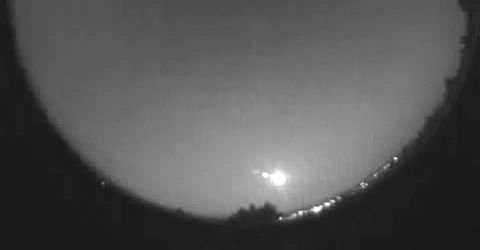The following blog post is based on information provided by College of the Rockies’ Lab Assistant, Rick Nowell.
On Sunday, September 4, a huge fireball lit up Cranbrook’s entire western horizon. It appeared as a fast-moving ball of yellow light, rapidly gaining brightness until it resembled a blue-white welding arc. A small orange globule broke off and followed along behind the first fireball until it suddenly flared into a brilliant white light, illuminating the sky for miles around. Out of the white light came another large blue-white fireball with a smaller orange one chasing after it. These fireballs appeared to drop over the horizon into the smoke haze and out of sight. Minutes later a dull rumbling, resembling thunder, could be heard.
A witness in Crawford Bay almost ducked as she saw the fireballs overhead and then felt the vibration of the rumbling in her chest. For a second she imagined that it had been a nuclear bomb blast. “I’m not kidding,” she says. “It was that loud.”
It was thankfully not a nuclear bomb blast. Nor were we invaded by aliens. The fireballs and thunderous noise were, in fact, caused by a meteor, with pieces falling off as it made its way to Earth.
So, where did these meteor pieces hit the ground? BC has a network of meteor cam stations, including one at College of the Rockies which tracked the meteor for about 10 seconds. Combining the College’s sighting with a good video from Spokane, Washington (near Gonzaga University) and a photo from just south of Crawford Bay, retired mathematician from the Finnish Fireball Network (yup, that’s a thing!) Esko Lyytinen believes the primary (50 kg) piece would have hit the Earth about 5 km east of Kaslo. The 100 g fragment from the brightest flash would have hit about 2.5 km south and 1 km east of Riondel.
Anyone interested in looking for fragments of the meteor would likely do well to search the northeast area of Crawford Bay as well as the road from Gray Creek North to Crawford Bay. Because the meteor fragmented, the impact would not create craters. In addition, meteors that strike the ground are not smoking hot as depicted in Hollywood movies (good thing considering our fire risk at the time).
If you’re looking for a fragment – what should you look for? Esko believes it is likely a common, stony non-metallic meteorite – known as a chondrite. In your search, look for rocks that a magnet will stick to. The surface might have a thin grayish fusion crust (a thin, melted layer one or two cm thick) and scattered thumb-sized hollows. You’ll want to ignore layered sedimentary rock since these require an ocean to form. Also, if the rock you find has holes or bubbles inside (like pumice) that was likely formed from lava flows, again not likely to exist in an asteroid from outer space.
The College’s meteor camera has seen large fireballs that have hit the ground about four times in the past six years, including:
- December 20, 2014 over Canal Flats, BC (possibly a rare carbonaceous chondrite)
- September 26, 2011 over Banff, AB
- May 14, 20122 over Creston, BC
Shared videos from the College and other ground stations in the BC Meteor Network (West Kelowna, Penticton, Courtney, Vancouver and/or Prince George), makes it possible to triangulate where these meteors impacted with an accuracy within 2 or 3 km. That gives those interested the chance to find rare meteorites and find out what they contain. The College also belongs to the Sandia National Laboratory North American meteor network – and we upload videos of fireballs there as well as to other scientific sites.
UPDATE: University of Calgary researchers found a fragment of the September 4th meteor – due, in part, to images captured by our video camera which provided valuable information.
Interested in learning more? Check out the College’s Elementary Astronomy course each September.
